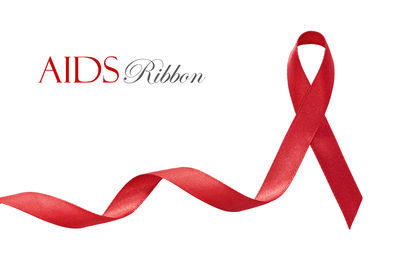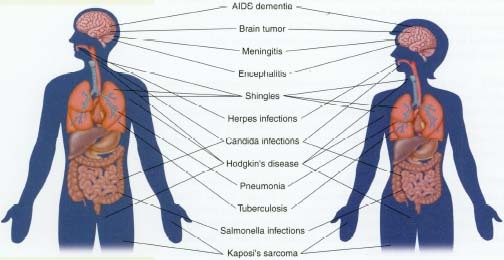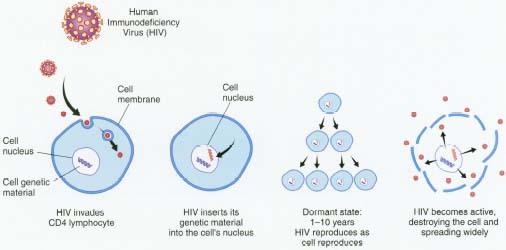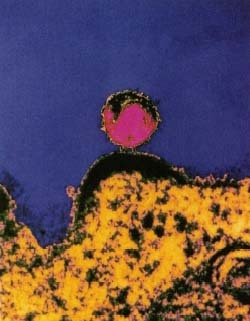AIDS and HIV

AIDS is the most severe form of disease caused by HIV (human immunodeficiency virus), a virus that damages the immune system, leaving a person open to many life-threatening infections.
KEYWORDS
for searching the Internet and other reference sources
Epidemic
HAART
Immunodeficiency
Infection
Protease inhibitors
Retrovirus
Virology
How Did the AIDS Epidemic Begin?
In the early 1980s, doctors in New York and California began noticing a very unusual disease in a small number of young men. The men, who were mostly homosexual, were developing unusual infections and cancers, and some of them were dying. The infections were similar to those seen in children who are born with very weak immune systems. But these men had been healthy as children and should have had normal immune systems.
Government scientists searched for other cases of the disease, and found more and more of them. The disease also seemed to strike people who had received blood transfusions, and drug addicts who had shared needles with each other. Reports of the disease began to come in from other countries, including African and Caribbean countries, where it seemed to spread mainly by sexual contact between men and women. Some babies were born with it, too.
AIDS
Less than 20 years later, that mysterious disease had become one of the worst epidemics ever to strike humanity. AIDS (acquired immune deficiency syndrome) had killed almost 14 million people worldwide, including more than 3 million children, by the end of 1998. In the United States, AIDS had killed more than 400,000 people, including almost 5,000 children younger than age 15.
HIV
Even greater numbers of people are infected with the virus that causes AIDS, but have not yet developed the disease. In the United States, almost a million people are thought to be infected with HIV, the human immunodeficiency virus, and most do not know they are carrying the virus that causes AIDS. Within 10 years of becoming infected, about half of them will have developed AIDS. Worldwide, more than 33 million people are living with HIV infection, mostly in developing countries in Africa and Asia.
People at risk
Like other sexually transmitted diseases, HIV infection is a particular risk among teenagers and young adults. In the United States, more than 110,000 people in their twenties have been diagnosed with AIDS, and it is likely that most of them became infected with HIV when they were teenagers. It is estimated that up to one quarter of all HIV infections in the United States—and half of all HIV infections worldwide—occur in teenagers and people in their early twenties.
Many billions of dollars have been spent to understand HIV/AIDS, to prevent it, and to treat it. Although there is still no cure and no proven vaccine, there has been progress. Because of new drugs, the number of deaths from AIDS fell sharply in the United States starting in 1996. Many Americans infected with HIV are living longer and better lives: they are going to school, working, raising their families, and enjoying life. There is hope that in the United States, HIV will soon be similar to other chronic * diseases, like diabetes or asthma: a serious disease, but one that is manageable with good medical care.
* chronic (KRON-ik) means continuing for a long period of time.
But in most other parts of the world, treatment is far too expensive for people with HIV and AIDS, and the epidemic is growing worse each year. Developing nations in Africa, Asia, the Caribbean, and South America have been hit hard. In some parts of Africa, the virus has infected a quarter of all adults and is reversing years of struggle to improve living conditions. Life expectancy is falling, and infant mortality (the infant death rate) is rising.

Even in the United States, it is estimated that 40,000 people a year are still getting infected with HIV and, unless treatment improves, it still appears that almost all HIV-infected people will eventually die of AIDS.
Carl's Family: How Could This Happen?
When Carl's mother told him she had HIV, he could not believe it. After all, she worked full time, kept house, volunteered at church, and was raising two kids alone. She was the last person in the world he could imagine shooting up drugs. And in the eight years since Carl's father had died of a brain tumor, she had not been out on a date, let alone had relationships with men. How could she have caught HIV?
But Carl, now 15, found out that he had not been told the full story of his father's death. Yes, it had been cancer, but it was a kind of cancer—lymphoma of the brain—that is much more common in HIV-infected people. Carl's father had died of AIDS.
"I didn't know it until your father got sick," his mother said, "but when he was a teenager, your age, he got into drugs. He and his friends injected cocaine and heroin. After a couple of years, he stopped, he got his life together, and he even went to college. By the time he met me, he thought that other life was all behind him."
By the time Carl's father realized he had HIV in his body, he was already very sick. And he had already infected Carl's mother. Although a mother can pass HIV to her baby, neither Carl nor his sister was born infected. "It was just luck," his mother said. But Carl did not feel lucky.
How Does HIV Spread?
HIV infection can spread only when an infected person's body fluid (blood, semen, vaginal fluid, breast milk, or any body fluid containing blood) enters the bloodstream or contacts the mucous membrane * of another person.
Sexual intercourse, either homosexual (between men) or heterosexual (between men and women), is responsible for most cases of HIV infection. The virus also commonly spreads among people who share contaminated needles when they inject drugs. Infected mothers may pass it on to their babies during pregnancy, childbirth, or breast-feeding.
If blood is infected, transfusions can spread HIV. But in the United States, blood transfusions have been tested for HIV since 1985, and the risk of infection from a transfusion is extremely low.
Oral sex also can spread the virus, and at least one case has been reported in which the virus is thought to have spread through wet kissing (French kissing).
* mucous membrane is the kind of tissue that lines body openings, such as the mouth, vagina, and rectum, as well as the respiratory, intestinal, and genital tracts.
HIV does not spread through air, water, food, or objects like doorknobs or toilet seats. It is not spread by mosquitoes or by other insects. A person cannot "catch HIV" by playing with, going to school with, shaking hands with, hugging, or even living with an infected person. Fortunately, HIV is much less contagious than many other infections, including chickenpox, flu, or hepatitis B.
How Can HIV Infection Be Prevented?
Prevention of HIV infection is easy—and hard. People can completely protect themselves by never sharing needles, whether for drug use or such practices as tattooing or body piercing, and by avoiding all sexual contact. As people grow up and become sexually active, however, things become more difficult.
Safer sex
The safest sexual relationship is between two uninfected people who have sex only with each other, sometimes called a monogamous (mo-NA-ga-mus), mutually faithful relationship. But there is no sure way to tell if a person is infected or not. People with HIV may seem completely healthy and often do not know they are infected. In the first few months after infection, they may even test negative on HIV tests.
So if people are sexually active, how can they reduce their chances of infection? One important step is not to have sexual contact with anyone who may be at risk of HIV infection. Who is at risk? Anyone who ever shared needles or engaged in promiscuous sex (had many sexual partners), as well as anyone who ever had a sexual partner who shared needles or engaged in promiscuous sex. Of course, often people are not truthful about past behavior. To judge whether a potential sexual partner is being honest, or is at risk, it may help to know the person well, over a long period of time. Unfortunately, however, that, too, is no guarantee.
Other safety measures
Other steps to reduce the chances of infection include:
- using latex condoms correctly and consistently during sexual activity
- not engaging in anal sex or other sexual practices likely to cause breaks in the skin
- not having sexual relations with multiple sexual partners
- avoiding drugs and alcohol, since their use might prevent people from making good decisions about protecting themselves and others from HIV
- getting prompt treatment for any sore or blister in the genital area, since these can act as an open door for HIV to enter the body.
The U.S. and the World
The HIV/AIDS epidemic presents a very different picture in the United States and in the developing nations of the world, where 95 percent of all cases occur.
- Worldwide, more than 75 percent of all infections in adults result from sex between men and women. In the United States, male-female sex accounts for less than 20 percent of infections, although this percentage has been increasing. Instead, most U.S. infections result from sex between men orfrom needle-sharing by drug users. The reason forthis difference is not clear.
- Worldwide, the death toll of 13.9 million continues to rise. An estimated 2.5 million people died of AIDS in 1998 alone, including more than 500,000 children, most of whom had been infected before or at birth. But in the United States, the death toll started falling in the late 1990s. From 1996 to 1997, for instance, it fell from 37,525 to 21,909.
- Worldwide, about 1 in every 100 adults (ages 15 to 49) is infected. But in more than a dozen African nations, more than 10 in 100 people are infected. In some nations, including Botswana and Zimbabwe, more than 20 in 100 people have HIV. In the United States, the overall infection rate is about 1 in 200.
- Worldwide, the epidemic has created more than 8 million "AIDS orphans," childrenyoungerthan age 15 who have lost their mother or both parents to the disease. Ninety-five percent of them live in Africa. Less than half of 1 percent (about 45,000) live in the United States.
- Worldwide, the number of children with AIDS continues to grow as more infected mothers pass on the virus to their babies. But in the United States, the number of children with AIDS fell in the late 1990s because treatment of mothers prevented the virus from spreading to their babies.
What Does HIV Do in the Body?
Once HIV gets into the body, it attacks and enters white blood cells called CD4 helper lymphocytes (LIM-fo-sites). These cells are very important for the proper functioning of the immune system. When the virus begins to destroy CD4 cells more rapidly than the body can replace them, the immune system becomes so weak that severe infections and cancers can develop. The virus also can directly attack some organs, including the brain, the kidneys, and the heart.

HIV is a special kind of virus called a retrovirus (see sidebar) and includes two species, or types. HIV-1, which is far more common and more severe, has caused the current epidemic. Different subtypes of it occur in different parts of the world. HIV-2, which is seen in some parts of West Africa, causes a milder version of AIDS.
One reason it has been impossible so far to find an HIV cure or vaccine is that the virus can mutate and change its genetic features with amazing speed. That means HIV can quickly grow resistant to a medicine, making the drug no longer effective. It also means that any drug or vaccine must be able to work against a wide range of different strains of HIV.
What Are the Symptoms?
HIV Infection
Between two and four weeks after people get infected, most people develop a flu-like illness with fever, sore throat, muscle aches, and (often) a rash that looks a little like measles. After two weeks, this illness usually disappears. Others, however, get infected with no initial symptoms of illness. A person can transmit HIV to others without having had any symptoms.
Over the next few years, a person may suffer fevers, swollen glands, fatigue, weight loss, and diarrhea. These symptoms generally occur long before the serious complications that come with AIDS. Some people may have minor infections such as thrush (a yeast infection of the mouth) or shingles (a skin infection caused by the virus that causes chickenpox). Others do not have any symptoms until they develop AIDS itself.
Children, especially those who were infected before they were born, generally develop symptoms more quickly than adults. Often they are sick from birth or may fail to grow and develop at a normal rate.
AIDS
AIDS is often heralded by infections or cancers that occur only in people whose immune systems have become very weak. Some of the most common are:
- Pneumocystis carinii (nu-mo-SIS-tis ka-RIN-ee) pneumonia (PCP), the most common complication of AIDS in the United States since the epidemic began. It causes fever, cough, and shortness of breath.
- Cerebral toxoplasmosis (tok-so-plaz-MO-sis), which can destroy parts of the brain. It usually begins with a headache and often paralyzes one side of the body.
- Cryptococcal meningitis (krip-to-KOK-al menin-JI-tis), an infection of the brain and of the meninges, which is the membrane lining the central nervous system. It begins with fever and headache, and it can cause coma.
- Intestinal infections caused by parasites such as cryptosporidiosis (krip-to-spo-rid-e-O-sis) or isosporiasis (i-sos-po-RY-a-sis).
- Eye infections caused by cytomegalovirus, which can cause blindness.
- Infections caused by bacteria called Mycobacterium avium, which resemble tuberculosis.
- Cancers, including Kaposi's sarcoma (which causes purplish skin nodules), lymphoma (which may affect any organ, especially the brain and intestinal tract), and invasive cervical cancer (a genitaltract cancer in women).
- AIDS dementia, in which people have difficulty thinking, remembering, and concentrating.
- In addition, many common infections (such as syphilis and ordinary pneumonia) are more common or more severe in people with AIDS. The most striking example is tuberculosis, which is 100 times more likely to cause illness in a person who has HIV than in an uninfected person.

The illnesses described above often are treatable, and some can be prevented with medication. But they keep recurring. People who are said to "die of AIDS" usually die from one of these illnesses. Worldwide, for instance, it is estimated that tuberculosis kills as many as 1 in 3 people with AIDS.
How Is HIV/AIDS Diagnosed?
Doctors may suspect HIV infection from the symptoms, especially if a person has one of the rare infections mentioned above. But HIV infection can only be diagnosed by blood tests.
Testing for HIV
Doctors recommend testing for all people who think they may have been exposed. Testing is also recommended for all pregnant women and for newborns whose mothers either tested positive for HIV or were not tested during pregnancy. Such testing should lead to treatment that cuts the baby's risk of getting HIV from the mother. Treating an infected woman with the drug AZT (zidovudine) during pregnancy and delivery, and treating her newborn with the same drug after birth, reduces the baby's risk of getting HIV from about 25 percent to about 6 percent.
The most common HIV test detects antibodies, which are substances the body makes to fight the virus. This test may not show infection until several months after it has occurred. For that reason, a person who was recently infected may test negative. So people who think they may have been exposed to the virus should be tested immediately and again six months later.
Where Did HIV Come From?
Since the identification of AIDS in 1981, and the discovery of HIV (the human immunodeficiency virus that causes AIDS) in 1983, scientists have tried to discover the origin of the virus. They came to suspect that it had developed in Africa from a monkey virus known as SIV (simian immunodeficiency virus) and that it might have spread to humans from chimpanzees.
But it was not until 1999 that an international team of researchers found what could be the missing link: a virus that seems to be a genetic blend of HIV and SIV. It was found in one subspecies of chimpanzee, Pan troglodytes troglodytes, but it seems to cause them no illness. Researchers suspect that humans first became infected with SIV about 50 years ago when they were exposed to the chimps' blood while hunting the animals for food. Once in humans, it appears, the virus changed into the deadlier HIV we know today.
Researchers were elated at the discovery of the microbe they called SIVcpz (cpz stands for chimpanzee). Because it does not make infected chimps sick, studying what it does in their bodies may help scientists learn how to prevent HIV from making people sick. And it may help them prevent the spread of other viruses to humans in the future.
But the scientists got a harsh surprise. The type of chimp involved, they learned, soon may be extinct in the wild. Logging is driving the animals out of their rainforest homes in West and Central Africa, and they are being butchered as game meat. Now scientists are trying to save the chimps, as well as study them.
"We cannot afford to lose these animals," said Dr. Beatrice Hahn of the University of Alabama, one of the lead researchers involved. "Chimpanzees may represent both cause and solution to the AIDS problem."
What Is a Retrovirus?
One reason HIV is so dangerous is that it is a special kind of virus—a retrovirus. This means that it reproduces itself in a backward or "retro" manner. To understand what that means, it helps to know some basic information about viruses.
Viruses are tiny microbes—much smaller than bacteria—that are made largely of nucleic acid, the substance that makes up genes. They work by invading a cell and using the cell's energy and machinery to make copies of themselves.
The virus's nucleic acid may be either DNA (deoxyribonucleic acid) or RNA (ribonucleic acid). DNA viruses make direct copies of their DNA, and most RNA viruses make copies of their RNA. This copying process is called transcription. Retroviruses contain RNA but copy it into DNA in a process called reverse transcription. Then the viral DNA—called a provirus—is inserted directly into the genetic core of the cell. That means that wheneverthe cell reproduces itself, by making copies of its own DNA, it also makes copies of the retrovirus's DNA.
In the case of HIV, the virus invades CD4 helper lymphocytes, which are white blood cells important to the immune system.
In addition, for the first year or so of life, a baby born to an infected mother may test positive for HIV even if the baby is not infected.
Testing for CD4 lymphocytes
Once a person is known to be infected, a different blood test is done periodically to see how well the person's immune system is working. The test measures the level of CD4 lymphocytes, the type of white blood cell targeted by HIV. If the number of these cells falls below a certain level—or if the person has certain severe infections like those described earlier—then the person is said to have AIDS.
How Is HIV/AIDS Treated?
Drugs to fight the virus directly are generally prescribed as soon after infection as possible. These drugs block protease and reverse transcriptase, which are important enzymes * that the virus makes in order to reproduce itself. The drugs are used in combinations of three to five medications, which is a form of treatment called HAART (highly active antiretroviral therapy).
The most powerful of these drugs are also the newest, so no one knows how effective they may be in the long run. But it is clear that they postpone the development of AIDS and often make other symptoms less frequent and less severe. Unfortunately, HIV may become resistant to one or more of the drugs. In addition, all the anti-HIV drugs have side effects that make them difficult for many patients to take. It is not yet known whether these drugs reduce the chance that an infected person will pass HIV to someone else.
Besides the antiviral drugs that attack HIV directly, other medications can help prevent or treat some of the serious infections that come with AIDS.
Bob's Story: Hanging on for Something Better
Bob became infected with HIV as a teenager, when he began to realize he was gay and had sex with a series of strangers without using condoms. At the time, he was feeling confirsed, lonely, and reckless. But he also thought his sexual partners were too young to be infected.
Now Bob is 25 and has AIDS, but his doctor says he is doing well. To keep things that way, Bob takes five different medicines—19 pills—every day. Two of them are easy: he takes one pill each to prevent pneumonia and to control a yeast infection that he always seems to have in his mouth and throat. The pneumonia pill is big and hard to swallow, but the other one is not as bad. The other three medicines attack HIV directly. They include AZT, the oldest anti-HIV drug; epivir, a newer but similar drug, and nelfinavir, a type of drug called a protease inhibitor. Bob is supposed to take six pills in the morning, five at lunchtime, and six at suppertime.
* enzymes are natural substances that speed up specific chemical reactions in the body.
Histoplasmosis and HIV
In some areas of the United States, especially southern and southwestern areas, almost 80 percent of the population tests positive for the fungal infection histoplasmosis (his-to-plaz-MO-sis).
In the past, only people with severe cases of histoplasmosis required treatment, but HIV and AIDS have caused an increase in those numbers.
People with HIV, AIDS, and other immune system diseases should avoid activities that increase their chance of exposure to histoplasmosis. Such activities include cleaning chicken coops, disturbing soil beneath bird-roosting sites, and exploring caves. Once infected, people with histoplasmosis and HIV require ongoing treatment.
Bob drives a cab. When he gets busy at work, it is hard for him to remember to take the pills at just the right time and to be sure he has water with him. Plus, the nelfinavir gives him diarrhea. He has also noticed that he is beginning to develop a large pot belly. His doctor warned him that the nelfinavir might cause this.
Some days he feels encouraged thinking how the drugs are helping him. Other days he gets so depressed about all the pills and the side effects that he feels like giving up. But for now, he has decided to do what the doctor said and try never to miss a single dose. He just hopes he can keep hanging on and that better medicines come out soon.
Living with HIV/AIDS
In the early days of the epidemic, parents picketed outside schools to keep HIV-infected children out, and workers feared sitting next to someone with AIDS. Today, most Americans realize that HIV cannot be caught just by being around someone who has it. But people infected with HIV still can face stigma and discrimination. For many people, telling family and friends they are infected also means revealing something they have been keeping secret about themselves—that they are gay, or that they have used illegal drugs, or that they have had sex with many people. This can be very difficult, especially for young people who are gay and may fear rejection by their families. Often, however, people with HIV find that family and friends are very supportive.
To help stay healthy with HIV, good health habits become even more important. These include:
- for everyone: eating ample amounts of nutritious food, exercising, and getting adequate rest
- for drug addicts: stopping drug use
- for smokers: quitting smoking
- for people who have no symptoms: getting regular checkups, preferably by doctors who have a lot of experience treating HIV/AIDS
- for people who are taking medications: taking them properly and consistently, because taking these medicines on and off can cause a person's virus to become resistant to them.
Many people with HIV live normal lives for many years. Even those who struggle with bouts of illness often carry on with great fortitude and continue to enjoy their lives, just like people with any other chronic, life-threatening illness.
Protease Inhibitors
Protease (PRO-tee-ace) inhibitors slow down the spread of HIV. Protease is an enzyme that HIV uses to cut long protein chains and other enzymes into small pieces. HIV then uses the small pieces to make copies of itself. Protease inhibitors are drugs that are similartothe protein chains that the protease enzyme normally cuts. The inhibitors work by interfering with the cutting action.
Protease inhibitors do not stop HIV from making copies of itself, but with use of the inhibitors, many of the HIV copies are defective containing improperly cut pieces.
Because the copies are defective, they cannot infect other cells. Protease inhibitors do not kill the virus, but they greatly reduce the number of infectious virus copies made, which slows down the spread of HIV through the body.

Resources
Books
Brodman, Michael, M.D., JohnThacker, and Rachel Kranz. Straight Talk About Sexually Transmitted Diseases. New York: Facts on File, 1994. This book focuses on prevention for young people and includes explicit discussion of more and less risky sexual activity.
Monette, Paul. Borrowed Time: An AIDS Memoir. New York: Harcourt, 1998. This is the story of a gay couple living with AIDS during the early days of the epidemic.
Organizations
Aegis.com . This is an online AIDS bulletin board service run by a nonprofit foundation. Its database is particularly strong on treatment options, news articles from around the world, history, and legal rulings. It offers a package called The Basics for people who have just learned they have HIV http://www.aegis.com
National AIDS Hotline/HIV Hotline. This 24-hour service is run under the
auspices of the U.S. Centers for Disease Control and Prevention (CDC).
Telephone 800-342-AIDS
The National Institutes of Health offer information on their website.
http://ww.niaid.nih.gov/publications/hivaids.htm
The U.S. Centers for Disease Control and Prevention (CDC) has a Division
of HIV/AIDS Prevention website that offers information and links to
other federal websites.
http://www.cdc.gov/aids
http://www.cdc.gov/hiv
http://www.cdc.gov/nchstp/hiv_aids/dhap.htm
The World Health Organization's WHO Initiative on HIV/AIDS and
Sexually Transmitted Infections (HIS) posts country-specific information
and fact sheets about AIDS at its website.
http://www.who.int/asd/
See also
Cancer
Cyclosporiasis and Cryptosporidiosis
Cytomegalovirus
Immunodeficiency
Lymphoma/Hodgkin's Disease
Meningitis
Parasitic Diseases
Pneumonia
Pregnancy, Complications of
Sexually Transmitted Diseases
Shingles
Substance Abuse
Syphilis
Thrush
Toxoplasmosis
Tuberculosis
Uterine/Cervical Cancer
Viral Infections
Comment about this article, ask questions, or add new information about this topic: